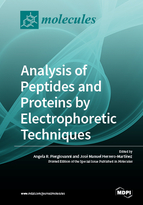Analysis of Peptides and Proteins by Electrophoretic Techniques
A special issue of Molecules (ISSN 1420-3049). This special issue belongs to the section "Analytical Chemistry".
Deadline for manuscript submissions: closed (30 April 2019) | Viewed by 29268
Special Issue Editors
Interests: characterization and evaluation of Italian landraces of legume species; evaluation of grain nutritional quality; measurement of anti-nutritional and toxic compounds; characterization of germplasm segments
Special Issues, Collections and Topics in MDPI journals
Interests: porous materials; nanomaterials; molecular recognition sorbents; sample treatment; solid-phase extraction; capillary electromigration techniques; capillary/nano liquid chromatography; food analysis
Special Issues, Collections and Topics in MDPI journals
Special Issue Information
Dear Colleagues,
The characterization of real complex matrices containing peptides and proteins constitutes a relevant issue in the research of life and biological sciences. To understand their functions in animals, plants, and food, studies of their expression levels, post-translational modifications, and specific interactions are crucial. Moreover, proteins and peptides are important biomarkers of many human diseases. Increase in our knowledge on this subject could help to develop biopharmaceuticals. Separation techniques, based on electromigration, coupled to sensitive detection methodologies, have enabled researchers to address these challenging issues. Recently, miniaturized electromigration techniques, including separations achieved in narrow fused silica capillaries or other microdevices, have increased separation efficiency and speed of analysis, reducing sample consumption and waste production.
The present Special Issue, “Analysis of Peptides and Proteins by Electrophoretic Techniques”, aims to collect and to spread some of the most significant and recent advancements in the study of theses macromolecules. The scope is broad, regarding the use of capillary electrophoresis (CE), chip-based and other miniaturized supports, as well as slab gels to characterize complex mixtures of peptides and proteins. Relevant applications to real matrices (biological fluids, plant extracts, food, etc.) and new technological developments such as microfluidics hyphenated with mass spectrometry, as well as future directions of these techniques, are welcomed.
Prof. Dr. Angela R. Piergiovanni
Prof. Dr. José Manuel Herrero-Martínez
Guest Editors
Manuscript Submission Information
Manuscripts should be submitted online at www.mdpi.com by registering and logging in to this website. Once you are registered, click here to go to the submission form. Manuscripts can be submitted until the deadline. All submissions that pass pre-check are peer-reviewed. Accepted papers will be published continuously in the journal (as soon as accepted) and will be listed together on the special issue website. Research articles, review articles as well as short communications are invited. For planned papers, a title and short abstract (about 100 words) can be sent to the Editorial Office for announcement on this website.
Submitted manuscripts should not have been published previously, nor be under consideration for publication elsewhere (except conference proceedings papers). All manuscripts are thoroughly refereed through a single-blind peer-review process. A guide for authors and other relevant information for submission of manuscripts is available on the Instructions for Authors page. Molecules is an international peer-reviewed open access semimonthly journal published by MDPI.
Please visit the Instructions for Authors page before submitting a manuscript. The Article Processing Charge (APC) for publication in this open access journal is 2700 CHF (Swiss Francs). Submitted papers should be well formatted and use good English. Authors may use MDPI's English editing service prior to publication or during author revisions.
Keywords
- slab-gel electrophoresis
- capillary electromigration techniques
- chip based and capillary based CE
- protein and/or peptides mixtures characterization
- hyphenation with mass spectrometry
- proteomics
- metabolomics







